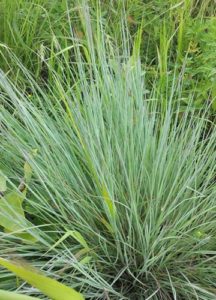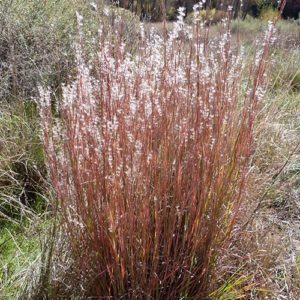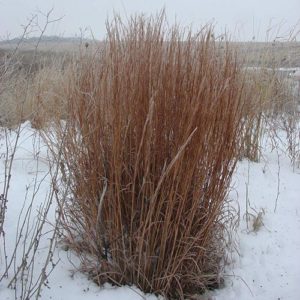Little bluestem (Schizachyrium scoparium) is native to the lower parts of Canada and almost the entire lower 48 states in the U.S. It can be found growing naturally in barrens, prairies, savannas, and open woodlands. Little bluestem prefers drier upland sites, but is occasionally found in lower moister areas, especially in some parts of its range. Overall, it is a very drought tolerant plant.
Like many of our other native grasses, little bluestem is a warm-season, bunch grass. As a warm-season grass, it needs the temperatures to be fairly warm before it will start to put out new growth. In other words, this isn’t a grass that is going to start greening up with the first signs of spring. The fact that it is a bunch grass is also very important.
Many of the grasses that we may be more familiar with, like Johnson grass or our yard grasses, spread by rhizomes and produce a solid mat of vegetation. Bunch grasses, like little bluestem, don’t do that. Instead, they produce tight clumps of vegetation. You can have multiple clumps close together, but there is always space between the clumps. This creates natural paths and runways for small mammals, as well as, quail and other birds that spend a significant amount of time on the ground.

Little bluestem gets its name from the blue-green color of its new growth in the spring. It also tends to be shorter than its cousin, big bluestem. In the fall, it turns somewhere between a golden brown and a deep mahogany color. The stems will stay standing most, if not all, of the winter, even if it snows.
In the late summer (Aug. through Oct. in Kentucky), little bluestem produces purplish-bronze flowers. The flowers are wind pollinated, so don’t need an insect to visit in order to be pollinated. Pollinated flowers will produce seeds with fluffy white “beards.” The seeds will often stay attached to the stems throughout the winter. When the seeds finally do fall off the stems, their fluffy white beards allow them to be blown for short distances in the wind. It is estimated that wind-blown little bluestem seeds usually travel no more than 5 to 6 feet, and that dispersals further than that are likely due to accidental transport by animals.
Typically, little bluestem will grow to between 2 and 4 feet tall, but it can get 6 feet tall or more. Mature clump size is often in the 1.5-to-2-foot range. However, there is a lot of ecoregional variation with little bluestem. This ecoregional variation can affect how tall the plant grows, how big the clumps get, the color of the leaves, its flowering properties, etc.
Land use changes over the last few hundred years have caused a decrease in wild little bluestem populations. Many of these are the same land use changes that have caused declines in many other prairie-based and open-land species, especially in the eastern U.S.
Little bluestem is very much a sun-loving species and can’t tolerate much shade. When fire was removed from the landscape, much of the eastern U.S. which used to be a patchwork of open and semi-open grasslands turned into dense forests. One study in Tennessee showed that without fire to keep the woods open, little bluestem was completely shaded out and lost within eight years. Other factors that limit tree growth, such as shallow soils, have also been shown to be beneficial for little bluestem populations. The key being that by limiting tree growth, these factors help prevent little bluestem from being shaded out.

Pollinator and Wildlife Uses:
Little bluestem is a valuable plant for many different types of pollinators and wildlife. A wide variety of animals use little bluestem as a food source. Deer (and bison in the past) will forage on the vegetation. Many different types of grasshoppers, beetles, spittlebugs, leafhoppers, and other herbivorous insects also eat the vegetation. In the eastern U.S., those “other herbivorous insects” include the caterpillars of at least five species of skippers that use little bluestem as a host plant.
The seeds are another important food source for several species of seed-eating songbirds and small mammals. This is especially true in the winter when other natural seed sources may not be as abundant. In addition to being used directly as a food source, little bluestem also creates a smorgasbord of tasty insects for our insectivorous songbirds.
The clumping nature of little bluestem also adds to its value for pollinators and wildlife. The growth form of the clumps, or bunches, creates natural runways, tunnels, and ally ways. Quail, ground-nesting songbirds, and small mammals use these natural paths to maneuver through the grassland while the vegetation above them provides some level of protection from larger predators. During the winter, bumble bee queens, the caterpillars of at least one species of skipper, and several small mammal species may overwinter in the protected space at the base of the clumps.
Incorporating Little Bluestem into Your Yard:
Little bluestem can be used as a native ornamental grass or planted in a pollinator or wildlife garden for all the reasons mentioned above. Native plant nurseries and seed companies often carry little bluestem and can be a great source for the straight species or wild type individuals. There are also multiple cultivars which can be found fairly easily at many traditional nurseries.
If planting little bluestem, especially the straight species or wild type individuals, then it is extremely important to get your seed from a source as close as possible to your site. If buying plants, instead of seeds, then it is important that whoever you are buying the plants from got their seeds from within your ecoregion.
Remember, this is a plant that shows a high amount of variability from one ecoregion to the next. Seed that originated from a different ecoregion may produce plants with very different characteristics (such as much taller) when they are grown in your ecoregion. Most reputable native plant nurseries and seed companies won’t mind you asking if the seeds or plants are from your ecoregion. Because of the intensive selective breeding that goes into developing cultivars, they may not show as much variability when planted in different ecoregions.
In addition to its benefits for wildlife and pollinators, little bluestem can create year-round interest in the garden. In the spring and early summer, it has a pretty blue-green color. In the fall, it turns golden brown to mahogany. In the late fall and winter, it is covered in fluffy white seeds which add additional visual interest. The dried grass stems and seed heads can also be used in cut flower arrangements or in winter wreaths.

When planting little bluestem, choose a sunny, relatively dry, well-drained location. Avoid places that are shady, wet, or have really rich soils. If little bluestem is planted in an area that is too shady, wet, or rich, then it could flop over or possibly even abandon its clumping nature for more of a mat-like growth form. If your little bluestem starts to develop any of these characteristics, then you might consider moving it to an area that is sunnier, drier, and/or has poorer soils.
Management of little bluestem is relatively easy. Its root system can go down as much as 5 feet, so it is relatively drought tolerant once established. (Like many plants, it may still need a little watering until it gets established.) As a warm season grass, it doesn’t start producing new growth until later in the spring when the temperatures have stabilized and warmed up. Many of your early spring plants will have significant growth and be well on their way before little bluestem thinks of getting started.
In some situations, especially small gardens, little bluestem can be somewhat aggressive and may become weedy. Most of this new growth comes from the seeds, not from vegetative growth or tillering. If this becomes a problem in your garden, you can cut off the seed heads instead of leaving them for the wildlife or for your own visual interest. Another option is to simply dig up any unwanted seedlings.
Little bluestem can be divided in the early spring, if the clump becomes larger than you would like. Also, occasionally cutting the dried grass back in the early spring can be beneficial and encourage new growth. This doesn’t have to be done every year, but this is a species that evolved with fire and large mammalian herbivory, so don’t be afraid to cut it back if it needs it. The Chicago Botanical Garden suggests that this be done about the time the narcissus bloom.
Please tell your friends about Backyard Ecology.
(Social media sharing buttons can be found below the footer.)

Backyard Ecology: Exploring Nature in Your Backyard
Nature isn’t just “out there.” It’s all around us, including right outside our doors. Hi, my name is Shannon Trimboli, and I am the host of Backyard Ecology. I live in southcentral Kentucky and am a wildlife biologist, educator, author, beekeeper, and owner of a nursery specializing in plants for pollinators and wildlife conservation. I invite you to join me as we ignite our curiosity and natural wonder, explore our yards and communities, and improve our local pollinator and wildlife habitat. Learn more or subscribe to my email list at www.backyardecology.net.

Leave a Reply